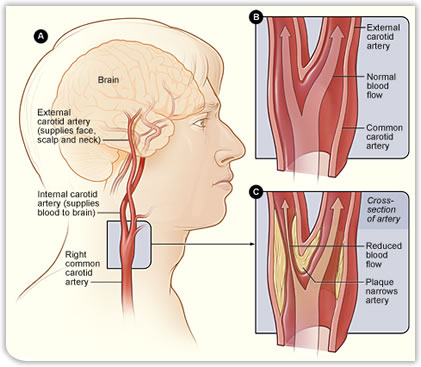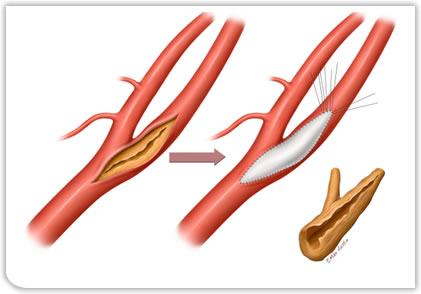What is a carotid endarterectomy?
A carotid endarterectomy is an operation to remove the disease that is narrowing the carotid artery. As mentioned above, the disease tends to occur around the place where the carotid artery divides into the internal and external carotid artery and the artery above and below this is normally fairly healthy. Therefore a limited incision just over this part of the carotid artery is enough to remove the disease. The operation can be done under local or general anaesthetic. I prefer to do it under local anaesthetic unless people have a strong preference. An incision is made over the carotid artery. The carotid artery is opened up and the diseased area shelled out. I then sew a patch onto the carotid artery in order to widen it and make it less likely for the narrowing to recur in future. The procedure normally takes about an hour and 40 minutes. People normally cope with the operation very well and it does not put a particularly big strain on the heart, lungs and so even people who are quite elderly and frail can cope with the surgery. In my practice people are normally discharged home on the following day (i.e. they stay in hospital for one night only).

Does carotid endarterectomy have any risks?
Yes, of course all operations carry risks and the issue is very much about weighing up the risk of not doing the carotid endarterectomy (having a stroke) against the risk of doing it. Unlike a major abdominal operation in which you know that if you have a large incision in the belly it is going to take some time to get over even if all goes well, carotid endarterectomy is usually tolerated very well. It is not particularly sore afterwards and people normally recover from it very quickly. However, it is an operation on the artery taking blood to the brain and therefore there is potential for serious problems to arise. It is important to recognise that there is a small potential for a stroke to occur as a result of the surgery. The risk of this happening is of the order of 3% and if a stroke does occur it may be a minor one, which recovers fully. However it is possible that it could be a very severe or even life-threatening stroke. Nonetheless the risk of ending up with a stroke without surgery is substantially higher than having a stroke if you do have surgery. That is the reason for doing the operation.
Other potential risks are affecting the nerves that control the tongue or the voice box. If this happens it is usually a temporary thing but it is possible for it to cause long-term weakness of the tongue or changes in the voice. As with any operation on an artery, bleeding can be an occasional problem and sometimes requires drainage. It is normal for people to notice a little bit of numbness around the scar which men tend to notice when they shave. This usually improves over time. It is important to get this in perspective. In general carotid surgery is extremely well tolerated and even elderly frail patients cope with it extremely well and make an excellent recovery. However there are very small chances of very big problems and of course if you were the person who has the problem it is of no help to you that everyone else was alright. It is important to weigh this up against the fact that there is very good evidence that people who are having symptoms from a narrowed carotid artery are at high risk of having further events and ending up with a stroke if nothing is done, as mentioned above. If people with symptomatic severe carotid artery disease are divided into two groups, one of which has surgery and medical treatment and the other has just medical treatment, there is excellent evidence from very large studies that the group who have surgery end up with fewer strokes than the ones who do not.

 Contact Me
Contact Me